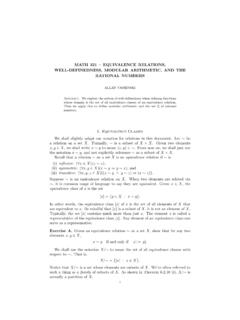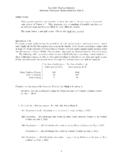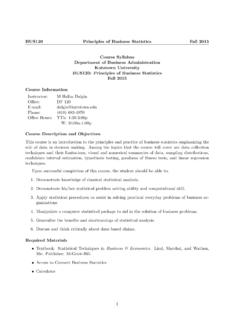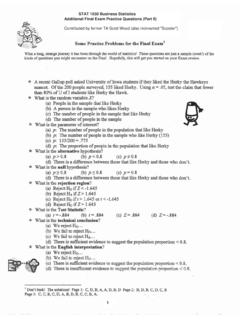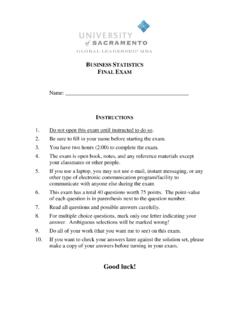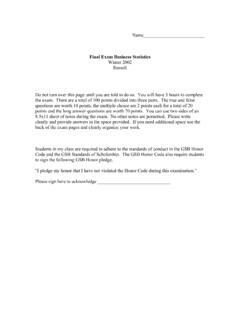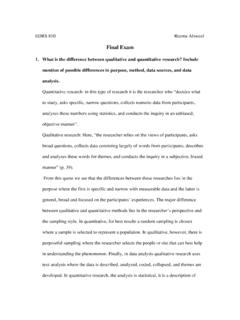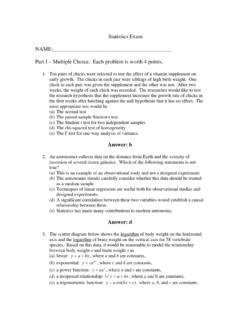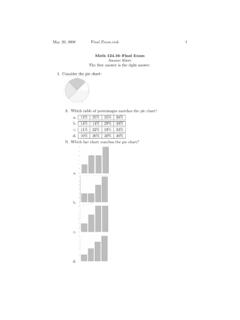Transcription of Elementary Probability and Statistics - University of …
1 Student name and ID number Elementary Probability and StatisticsFinal ExamJune 6, 2011 Instructor: Bj rn Kjos-HanssenDisclaimer:It is essential to write legibly andshow your work. If your work is absent orillegible, and at the same time your answer is not perfectly correct, then no partial credit canbe awarded. Completely correct answers which are given without justification may receivelittle or no this exam, you are not permitted to use notes, or books, nor to collaborate withothers. You are allowed to use a 100/75=/1000 Score:Problem 1.
2 [5 points] Suppose a store sells boxes of cream puffs. Each box contains 12cream puffs, and each cream puff is either chocolate cream or vanilla cream. The numberof chocolate cream puffs in a box has a mean of 4 and a standard deviation of If youbuy 7 boxes of cream puffs, what is the standard deviation of the number of vanilla creampuffs that you will get? You may assume that the numbers of vanilla cream puffs in differentboxes are independent of one : Since the number of vanilla is a constant minus the number of chocolate, weare just looking for the SD of the number of chocolates forn= 7, where = and = is n= 7 = :Problem 2.
3 [6pts]All the 143 Android phone visits to the web month were doneusing either the default web browser or the Opera Mini browser. Four visits used Opera Mini. 1 of these 4 was anew visit(the other three beingreturning visits). 139 visits used the default browser. 30 of these werenew ) [3 points] How many percent of all visits using Android phones were new visits?b) [3 points] What percentage of new visits used the default browser?Solution:1 + 30143= (a)30/31 = (b)2 Score:Problem that houses in La Jolla area are sold at a rate of per day, andthat on average, of the houses sold are built in the first half of 1963 or earlier (we willcall such houses old ).
4 Real estate agent Sally has noticed that the numbers of houses, old and new, and thenumbers of buyers and sellers in the market, are very large compared to the number ofsales that typically occur in a month. Therefore she adopts the following mathematicalmodeling assumptions: Ages of houses sold are independent of one another, and the numberof sales, and the time until the next sale, are independent across time periods. Based onthese assumptions answer (a)-(d) ) [3 points] Find the Probability that exactly 1 of the next 7 houses sold will be old.
5 B) [3 points] Find the Probability that exactly 8 houses will be sold in the next (7-day) ) [2 points] What is the Probability that it will be at least a 7-day week (from now)before the next house is sold?d) [2 points] Suppose no houses are sold in April. What is the Probability that no housewill be sold in the first 7-day week of May?Solution: (a) Binomial random variableXwithn= 7 andp=.133. ThenP(X= 1) =(71)p(1 p)6= 7(.133)(.867)6=.395.(b) Let nowXbe Poisson with = 7 ( ) = being the rate at which houses are soldper week.
6 ThenP(X= 8) =e 8/8! = (c) Let nowXbe an exponential random variable with = ThenP(X 1) = 1 P(X <1) = 1 10 e xdx= 1 (1 e ) =e ( )= =.08%(d) Same as (c),.08%, by the memoryless property of the exponential :Problem you read in the newspaper that 65% of men with mustaches (facialhair above the lips) also have a beard (facial hair below the lips). To test your theory, yousomehow draw a simple random sample of 10 men having a mustache. As it turns out, youobserve that none (zero) of these 10 men also has a ) [6 points] What can you conclude about whether or not the newspaper article you readwas accurate?
7 Make sure to state your hypotheses clearly, show how you calculatedyour test statistic, give the p-value (or an interval containing the p-value, if that isthe best you can do with your tables), and write a clear conclusion. You may use asignificance level of . 65%, letpbe the overall mean proportion among men with mustaches ofthose that also have a beard. We let the null hypothesisH0state thatp=p0and thealternative hypothesisHAstate thatp6=p0. (It is tempting but slightly wrong to letHAbep < p0, because initially the numberp0= 65% was not stated as being high orlow.)
8 We can do a p0 p0(1 p0)/n=0 .65 (.65)(.35)/10= 65 (65)(35)/10= 13 (13)(7)/10= 130/7 = to the TableZ, thep-value is +, , less than = 10 4. [Notethat if we used a binomial rather than normal random variable, the Probability wouldbe (.35)10=.28 10 4so we are probably on the right track.]b) [2 points] Explain what a Type I error would mean in the context of this Type I error would mean rejecting the null hypothesis even though it is true, inother words, concluding that the newspaper article was wrong even though actually itwas ) [2 points] Explain what the power of the test means in the context of this power of the test is the Probability that we will reject the null hypothesis, inthe case where the null hypothesis is false.
9 That is, the Probability in the case wherethe newspaper article is wrong, that we will be able to determine that using our test.[This Probability will depend on whatpactually is; if it is very close top0the poweris smaller for a fixedn.]4 Score:Problem 5.[1 point per question.]Suppose we have some data (x1,y1),(x2,y2),(x3,y3) given by (0,0),(1,1),(2,3).In the questions below, show how you are using a formula and end up giving your answerin numerical form; part (a) is shown as an example. Consult the Useful Formulas sheet ) Findx.
10 Solution:x=x1+x2+x33=0+1+23= ) Findy. Solution:y=0+1+33=43= ) (0 1)2+ (1 1)2+ (2 1)22= ) (0 43)2+ (1 43)2+ (3 43)22=13 16 + 1 + 252=13 21 = 7/3 = ) Find the correlation 11 7/3((0 1)(0 43) + (1 1)(1 43) + (2 1)(3 43))= 32 7(43+ 0 +53))=3 32 7= 2728= (f) Find the slope 27 728 3= 94=32(g) Find they-intercept b1x=43 32= 165 Score:(h) Finds= this point we have the regression line y=32x givesse= 1n 2((0 ( 16))2+ (1 43)2+ (3 (3 16))2)= 162+132+162=13 14+ 1 +14= 33 2=1 6=.408 Note the residuals are +1/3 and 1/6 and 1/6, and this is slightly bigger in absolutevalue.





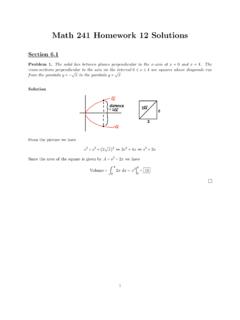

![Theorem [Division Algorithm]. d a q r a qd - math.hawaii.edu](/cache/preview/4/d/7/f/8/6/2/0/thumb-4d7f86202645f4ce3a151ad5df363960.jpg)

